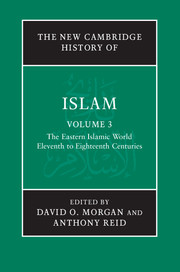Book contents
- Frontmatter
- Introduction: Islam in a plural Asia
- PART I THE IMPACT OF THE STEPPE PEOPLES
- PART II THE GUNPOWDER EMPIRES
- PART III THE MARITIME OECUMENE
- 9 Islamic trade, shipping, port-states and merchant communities in the Indian Ocean, seventh to sixteenth centuries
- 10 Early Muslim expansion in South-East Asia, eighth to fifteenth centuries
- 11 Follow the white camel: Islam in China to 1800
- 12 Islam in South-East Asia and the Indian Ocean littoral, 1500–1800: expansion, polarisation, synthesis
- 13 South-East Asian localisations of Islam and participation within a global umma, c. 1500–1800
- 14 Transition: the end of the old order – Iran in the eighteenth century
- PART IV THEMES
- Glossary
- Bibliography
- Index
- References
14 - Transition: the end of the old order – Iran in the eighteenth century
from PART III - THE MARITIME OECUMENE
Published online by Cambridge University Press: 28 March 2011
- Frontmatter
- Introduction: Islam in a plural Asia
- PART I THE IMPACT OF THE STEPPE PEOPLES
- PART II THE GUNPOWDER EMPIRES
- PART III THE MARITIME OECUMENE
- 9 Islamic trade, shipping, port-states and merchant communities in the Indian Ocean, seventh to sixteenth centuries
- 10 Early Muslim expansion in South-East Asia, eighth to fifteenth centuries
- 11 Follow the white camel: Islam in China to 1800
- 12 Islam in South-East Asia and the Indian Ocean littoral, 1500–1800: expansion, polarisation, synthesis
- 13 South-East Asian localisations of Islam and participation within a global umma, c. 1500–1800
- 14 Transition: the end of the old order – Iran in the eighteenth century
- PART IV THEMES
- Glossary
- Bibliography
- Index
- References
Summary
The nineteenth century in European history is often characterised as the ‘long’ century, which probably holds true for Iran, too, with the reign of the Qājārs from the late eighteenth century until 1925. Can the eighteenth century be seen as the ‘short’ century in Iran’s history? Very short, indeed, if the period begins in 1722 with the Safavid collapse and ends with Āghā Muḥammad Khan Qājār’s consolidation of power a half-century later. Iran’s eighteenth century is easily characterised by its dynastic fragmentation, when no fewer than five dynasties ruled Iran in that period: the Safavids, Afghans, Afshārs, Zands and Qājārs. There are the larger historical questions, too: on what basis does one era end and another begin? The Safavid era comes to its end in the eighteenth century and the Qājār period begins, but what about that arbitrarily designated period in between?
While there were dynastic changes, there was continuity in the eighteenth century in terms of political culture. Short-lived dynasties did result in weakened government institutions and in weakened, competing centres of power, which in turn directly affected Iran’s territorial integrity and debilitated Iran in face of both internal and external threats. Internally and parallel with the decline of central government was not just its inability to maintain order, but its administrative ineffectiveness and a corresponding strengthening of tribal power that further limited power at the centre.
- Type
- Chapter
- Information
- The New Cambridge History of Islam , pp. 504 - 526Publisher: Cambridge University PressPrint publication year: 2010
References
- 1
- Cited by



